In a stunning blow to one of the world’s most iconic tech giants, Apple Inc. saw its market value plummet by over $300 billion on Thursday, April 3, 2025, emerging as one of Wall Street’s most significant casualties amid U.S. President Donald Trump’s aggressive tariff rollout. Despite concerted efforts by Apple’s Chief Executive Officer, Tim Cook, to foster a favorable relationship with the Trump administration, the iPhone maker has found itself squarely in the crosshairs of a policy shift that threatens to reshape global trade and consumer markets.
Apple’s $300 Billion Market Value Plunge: A Casualty of Trump’s Tariff Blitz
The Tariff Trigger
The sharp decline follows Trump’s announcement of sweeping reciprocal tariffs, dubbed “Liberation Day,” which impose hefty levies on goods imported from key manufacturing hubs, including a 54% tariff on products from China—where over 90% of Apple’s iPhones are assembled. Unlike during Trump’s first term, when Cook successfully negotiated exemptions for several Apple products, no such relief has been granted this time. The tariffs, which took effect immediately on April 3, also hit other Apple production centers like India (27% tariff), undermining years of efforts to diversify supply chains away from China.
Analysts estimate that if Apple passes these costs onto consumers, iPhone prices could surge by as much as 43%, potentially pushing the cost of a base iPhone 16 to $1,142 and premium models like the iPhone Pro Max toward $2,300. Alternatively, absorbing the costs could erode Apple’s gross margins by up to 9%, according to Citi analysts—a scenario that could dent profitability at a time when iPhone sales growth has already been sluggish due to lackluster AI feature adoption.
Tim Cook’s Courtship Falls Short
Tim Cook’s strategic charm offensive with Trump appeared promising earlier this year. In February 2025, Cook announced a $500 billion investment in U.S. infrastructure over the next four years, a move Trump frequently touted as a hallmark of his administration’s economic success. Cook also attended Trump’s inauguration in January and dined with him at Mar-a-Lago in December 2024, signaling a pragmatic alignment with the administration’s “America First” agenda. Yet, these efforts have failed to shield Apple from the tariff storm.
“Apple was exempt in 2018, but this time there’s no word on relief,” noted Edison Lee, an analyst at Jefferies. “The market is baking in a worst-case scenario, but if exemptions or negotiations emerge, this could be a buying opportunity.”
Market Meltdown and Broader Impact
The tariff announcement triggered a broader market rout, with the S&P 500 plunging nearly 5%—its worst day since June 2020—and the tech-heavy Nasdaq dropping 6%. Apple’s stock, a bellwether for the sector, fell 9%, marking its seventh-worst single-day decline in two decades and wiping out nearly $300 billion in market capitalization. Posts on X echoed the shock, with users noting the irony of Cook’s $1 million donation to Trump’s campaign failing to secure leniency.
Beyond Apple, the tariffs threaten to ripple across industries, with retail giants like Walmart and Nike also bracing for cost spikes. Analysts at Rosenblatt Securities warned that the levies could “blow up an American icon,” potentially costing Apple up to $40 billion annually if consumer demand falters under higher prices. Meanwhile, Trump defended the policy, asserting on April 3 that the economic pain is a necessary step toward a “healing process” that will ultimately make the U.S. economy “boom.”
What’s Next for Apple?
Apple now faces a critical decision: absorb the tariff costs to maintain market share or pass them on to consumers at the risk of dampening demand. Angelo Zino of CFRA Research suggested that passing on more than 5-10% of the cost could prove challenging given shaky consumer sentiment. The company’s recent pivot to India and Vietnam for manufacturing, intended to mitigate China-related risks, has been undercut by tariffs on those nations as well—27% on India and undisclosed rates on Vietnam.
Investors and analysts are watching closely for signs of negotiation. Trump hinted at openness to deals during an April 3 press conference aboard Air Force One, mentioning potential talks with China over TikTok’s sale as a bargaining chip. For Apple, securing an exemption or phased implementation could soften the blow, but as of now, no such relief has materialized.
The Bigger Picture
The tariff blitz has drawn sharp criticism globally, with the EU, China, and Canada vowing retaliatory measures. French President Emmanuel Macron called the move “negative for the American economy,” while Canada imposed a 25% tariff on U.S. cars in response. Domestically, the Democratic Party labeled the tariffs “economic terrorism,” estimating a $30 trillion hit to the U.S. economy—or $300,000 per family of four.
For Apple, the immediate future hinges on its ability to navigate this turbulent landscape. With its stock sliding and Wall Street reeling, the tech titan’s resilience will be tested as it balances profitability, consumer loyalty, and an unpredictable trade war.
Add Business Connect magazine to your Google News feed



